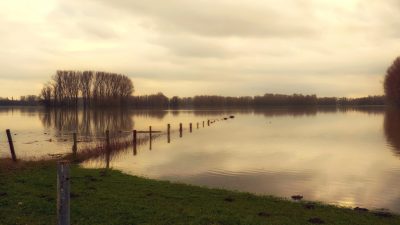A Devastating Natural Disaster that Shaped History
The 1931 China floods stand as one of the most devastating natural disasters in recorded history, with death toll estimates ranging from 1 million to 4 million people. Spanning from June to August 1931, these catastrophic floods were caused by a deadly combination of severe snowmelt, unprecedented rainfall, and multiple cyclones hitting the Yangtze River and other major waterways. The combination of these factors overwhelmed the country’s flood defenses, breaking riverbanks and causing widespread destruction. At its peak, the Yangtze River and the Yellow River reached flood levels never seen before, inundating over 180,000 square kilometers of land, displacing millions of people and destroying homes, crops, and infrastructure. Cities like Wuhan and Nanjing saw their population submerged, with waters rising several feet in some areas. The floods also led to a devastating public health crisis, with diseases like cholera and typhoid fever claiming countless additional lives. Over 75% of China’s agricultural land was destroyed, leading to severe food shortages. The economic impact was equally staggering, crippling China’s agricultural output and disrupting the lives of millions. In the aftermath, the Chinese government struggled to provide aid and manage the scale of the disaster, with much of the relief coming from international sources. The legacy of the 1931 floods pushed China to invest in long-term flood control systems and sparked changes in disaster management to prevent future tragedies.
What Caused the 1931 China Floods?
The 1931 China floods were the result of a perfect storm of environmental and climatic factors that combined to create one of the deadliest natural disasters in history. The key causes were:
- Severe Droughts (1928-1930): China faced intense droughts in the years leading up to the floods. From 1928 to 1930, prolonged droughts had already dried up rivers and significantly reduced water levels, causing the soil to be parched and unable to absorb rainfall properly when it came.
- Harsh Winter of 1930-1931: The winter preceding the floods was particularly cold, bringing heavy snowfall and freezing temperatures. This led to the accumulation of massive amounts of snow and ice in the mountainous regions, which, when it began to melt in the spring, added an overwhelming amount of water to the rivers.
- Rapid Snowmelt and Rainfall: As spring arrived in 1931, the melting snow quickly flowed into the Yangtze River and its tributaries. This snowmelt, combined with unprecedented rainfall in the summer months, created a deluge that the river systems could not contain. By June, the rivers had already swollen beyond their usual seasonal flood levels, exacerbating the crisis.
- Cyclonic Activity: The summer of 1931 saw nine cyclones strike the region in just July, far exceeding the normal rate of two cyclones per year. These storms intensified the rainfall and worsened the flooding by saturating the ground with additional water.
- Weak Infrastructure and Mismanagement: The region’s flood control infrastructure was outdated and weakened by years of neglect and mismanagement. Attempts to shore up dikes and build temporary flood barriers were ineffective, and the existing levees along the rivers were overwhelmed as the floodwaters rose.
A History of Natural Disasters in China
Historically, China has experienced frequent flooding due to its many rivers, especially the Yangtze and Yellow Rivers. While seasonal flooding is common, the 1931 floods surpassed all previous records in both scope and intensity, with floodwaters covering more than 180,000 square kilometers—an area larger than the entire state of New York.
The Perfect Storm: A Combination of Cyclones and Rain
By June 1931, the impact of multiple weather phenomena was already being felt. Over the summer, nine cyclones hit Central China—well above the normal two to three per year—dumping torrential rainfall on the already swollen rivers. As the floods continued, major cities like Wuhan and Nanjing became submerged. The rising water overwhelmed the local infrastructure, causing destruction across a massive swath of China’s heartland.
The Immediate Impact of the Floods
On August 1st, 1931, the Yangtze River finally broke its banks, sending floodwaters cascading into nearby villages and towns. Cities like Wuhan were devastated, with floodwaters reaching several feet high. Entire communities were wiped out, and survivors were forced to flee to higher ground, clinging to whatever they could find for shelter—trees, rooftops, or debris.
In addition to immediate flooding, the relentless rains and overflowing rivers led to widespread destruction of farmlands. Crops that were about to be harvested were completely destroyed, leaving millions without food and livelihoods. Furthermore, livestock drowned in the rising waters, worsening the humanitarian crisis. The scale of the disaster was so large that it became impossible to calculate the exact toll on the agricultural economy.
Widespread Disease and Public Health Crisis
In the aftermath of the floods, stagnant waters became breeding grounds for deadly waterborne diseases such as cholera, dysentery, and typhoid fever. These diseases spread quickly through overcrowded refugee camps, worsening an already dire situation. The toll on human life was further compounded by the lack of proper medical facilities and the sheer number of displaced people, some of whom were forced to survive in unsanitary conditions for weeks or months.
The Government Response: Inadequate and Overwhelmed
As floodwaters rose, the Chinese government struggled to respond effectively to the crisis. Flood control measures, already weakened by years of neglect, failed to prevent the disaster. Efforts to build temporary levees and repair damaged dikes were unsuccessful. In addition to inadequate local efforts, the central government was also caught up in internal political turmoil, limiting its ability to respond effectively to the flood disaster.
International aid arrived, but it was insufficient to meet the immense needs of those affected. Transportation routes were blocked, and basic supplies such as food, clean water, and medical aid could not reach the hardest-hit regions in time.
Economic Impact: The Long-Term Financial Cost
The economic impact of the 1931 floods was devastating. Agriculture, the backbone of China’s economy at the time, was severely disrupted. Floodwaters wiped out farmlands across the Yangtze River Valley, leaving millions without work and the nation facing severe food shortages. Rebuilding efforts were slow, and China’s already struggling economy faced further setbacks, affecting future growth and development for years.
Environmental Consequences of the 1931 Floods
On top of the human and economic devastation, the environmental impact was profound. Once fertile land turned into barren wastelands covered in debris and silt. The floodwaters deposited massive amounts of sediment, which changed the course of rivers and affected local ecosystems. In the long term, the region’s environmental landscape was altered, and it took decades for agriculture to recover.
The Death Toll: A Catastrophe Beyond Comprehension
The scale of the death toll from the 1931 China floods was staggering, with estimates ranging from 1 million to 4 million deaths, making it one of the deadliest natural disasters in human history. The exact death toll is difficult to determine due to the vast areas affected, but key factors contributing to this catastrophic loss of life include:
- Immediate Drowning: As the waters surged across cities and towns, many people were trapped in their homes or caught in the currents. Entire communities were submerged, and the floodwaters rose rapidly, leaving people with little time to escape.
- Disease Outbreaks: As the floodwaters receded, the stagnant water became a breeding ground for diseases like cholera, dysentery, and typhoid fever. The overcrowded refugee camps and unsanitary conditions contributed to the rapid spread of these deadly diseases, leading to further deaths.
- Malnutrition and Exposure: Many survivors were left without access to food, clean water, or shelter, contributing to widespread malnutrition and weakened immune systems. Those who survived the floods faced harsh conditions that ultimately led to deaths from exposure to the elements.
- Economic Collapse and Starvation: The floods destroyed crops and farmland, leaving millions without a source of livelihood. This destruction led to food shortages that left many people starving, especially in rural areas where the flood had devastated agricultural production.
- Government Response and Relief: Although international aid arrived, the Chinese government’s inability to effectively manage the disaster or provide sufficient relief efforts meant that many people suffered and died in the aftermath, amplifying the catastrophe.
This unprecedented loss of life left a permanent scar on China and was a significant factor in social unrest and political instability in the years following the disaster.
Social and Psychological Impact: A Nation in Trauma
The social impact of the disaster was profound. Whole families were wiped out, and survivors lost everything they owned. The psychological toll of the floods led to lasting trauma, as many people had to come to terms with the massive loss of life and their ruined communities. The flood affected mental health in a way that was deeply felt for years, as China’s infrastructure and governance systems were put to the test.
Rebuilding and Recovery: International Aid and Internal Efforts
Following the floods, international aid poured in, but the scale of the devastation made relief efforts challenging. Despite the best efforts of aid organizations, the Chinese government and local communities had to rebuild from scratch. In the years that followed, China focused on strengthening its flood management systems to prevent future disasters of this magnitude. The construction of dams, levees, and drainage systems were prioritized to better control flooding along the Yangtze and other rivers.
A Legacy of Lessons Learned
The 1931 China floods left a lasting legacy, shaping China’s disaster management approach for decades. The catastrophe revealed vulnerabilities in China’s infrastructure and governance, pushing the country to take action to improve flood defenses. It also sparked a national conversation about disaster preparedness, which led to improvements in early warning systems and the development of more resilient infrastructure.
Conclusion: A Reminder of the Fragility of Life
The 1931 China floods are a sobering reminder of how vulnerable human societies are to natural disasters. The event had far-reaching consequences on China’s population, economy, and society. While lessons learned from this disaster have made future responses to floods more effective, the memory of this tragedy serves as a stark reminder of the power of nature and the need for constant vigilance in disaster preparedness.
FAQs:
- What caused the 1931 China floods? The 1931 China floods were caused by a combination of melting snow, heavy rainfall, and a series of cyclones that overwhelmed the Yangtze River and other major rivers.
- How many people died in the 1931 China floods? The estimated death toll from the 1931 China floods ranges from 1 million to 4 million people, making it one of the deadliest natural disasters in history.
- What were the long-term consequences of the 1931 China floods? The floods had long-lasting economic, social, and environmental impacts. It led to significant crop losses, the destruction of infrastructure, and a rise in diseases like cholera.
- How did the Chinese government respond to the 1931 floods? The government struggled to respond effectively due to internal political instability and insufficient flood management infrastructure, leading to delays in aid and recovery efforts.
- What lessons were learned from the 1931 China floods? The floods led to major improvements in flood control infrastructure, including the construction of dams and levees, and a stronger focus on disaster preparedness in China.
References:
· Understanding the Forcing Mechanisms of the 1931 Summer Floods
journals.ametsoc.org
· 1931 China Floods: Overview, Causes & Effects
study.com
· The Chinese Flood of 1931
columban.org
· The Nature of Disaster in China: The 1931 Yangzi River Flood
amazon.com
· The Many Effects of Flooding
education.nationalgeographic.org
· Socio-economic Impacts on Flooding: A 4000-Year History of the Lower Yellow River
pmc.ncbi.nlm.nih.gov
· China Floods: Natural & Man-Made Disaster
verisk.com
Yt Links:
The Fifth Deadliest Flood Disaster | 1931 Yangtze River Floods
1931 China Floods Explained – Timeline of The Deadliest Natural Disaster in History | Scary Weather
PICS:




